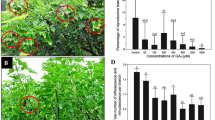Abstract
The application of gibberellic acid via the stem of intact preclimacteric carnation flowers inhibited the climacteric surge of ethylene evolution by the flowers. Gibberellic acid also inhibited the rate of ethylene production by all individual floral parts during both the early preclimacteric (low basal level of ethylene production) and the later climacteric stages of flower development. The extent of inhibition did however, vary from one floral part to another. The most pronounced inhibition was recorded in the petal bases between the preclimacteric and senescing stages. This suggests that the petal base is an important regulatory site for ethylene production and therefore may be involved in controlling the onset and degree of petal inrolling. In all floral parts endogenous levels of ACC were reduced with GA3 treatment, being more pronounced in the petal bases. The potential of the flowers to convert applied ACC to ethylene was not deminished by gibberellic acid.
Similar content being viewed by others
Abbreviations
- GA3 :
-
gibberellic acid
- ACC:
-
1-aminocyclopropane-1-carboxylic acid
- EFE:
-
ethylene forming enzyme
References
Adams DO and Yang SF (1979) Ethylene biosynthesis: identification of 1-aminocyclopropane-1-carboxylic acid as an intermediate in the conversion of methionine to ethylene. Proc Natl Acad Sci U.S.A. 76: 170–174
Cook EL and Van Staden J (1988) The carnation as a model for hormonal studies in flower senescence. Plant Physiol Biochem 26: 793–807
Eisinger W (1977) Role of cytokinins in carnation flower senescence. Plant Physiol 59: 707–709
Halevy AH and Mayak S (1981) Senescence and post harvest physiology of cut flowers. II. Hort Rev 3: 59–141
Hsieh Y and Sacalis J (1986) Levels of ACC in various floral parts during aging of cut carnations. J Amer Soc Hort Sci 111: 942–944
Lizada CC and Yang SF (1979) A simple and sensitive assay for 1-amino cyclopropane-1-carboxylic acid. Anal Biochem 100: 140–145
Manning K (1986) The ethylene forming enzyme system in carnation flowers. In: Roberts JA and Tucker GA, eds. Ethylene in Plant Development. University Nottingham, Nottingham pp 83–92
Mor Y, Halevy AH, Spiegelstein H and Mayak S (1985) The site of 1-amino cyclopropane-1-carboxylic acid synthesis in senescing carnation petals. Physiol Plant 65: 196–202
Mor Y, Spiegelstein H and Halevy AH (1983) Inhibition of ethylene production in carnation petals by cytokinins. Plant Physiol 71: 541–546
Mor Y and Reid MS (1981) Isolated petals — a useful system for studying flower senescence. Act Hort 113: 19–25
Nichols R (1966) Ethylene production during senescence of flowers. J Hort Sci 41: 279–290
Nichols R (1977) Sites of ethylene production in the pollinated and unpollinated carnation (Dianthus caryophyllus) inflorescence. Planta 135: 155–159
Ronen M and Mayak S (1981) Interrelationship between abscisic acid and ethylene in the control of senescence process in carnation flowers. J Exp Bot 32: 759–765
Saks Y and Van Staden J (1992) The role of gibberellic acid in senescence of carnation flowers. J Plant Physiol 139: 484–488
Saks Y, Van Staden J and Smith MT (1992) Effect of gibberellic acid on carnation flower senescence: Evidence that the delay of carnation flower senescence by gibberellic acid depends on the stage of flower development. Plant Growth Regul 11: 45–51
Tan ZY and Thimann KV (1989) The roles of carbon dioxide and abscisic acid in production of ethylene. Physiol Plant 75: 13–19
Veen H (1979) Effect of silver on ethylene synthesis and action in cut carnation. Planta 145: 467–470
Veen H and Kwakkenbos AAM (1982) The effect of silver thiosulphate pretreatment on aminocyclopropane-1-carboxylic acid content and action in cut carnations. J Plant Physiol 15: 389–396
Wulster G, Sacalis J and Janes HW (1982) Senescence in isolated carnation petals. Effect of indoleacetic acid and inhibition of protein synthesis. Plant Physiol 70: 1039–1043
Author information
Authors and Affiliations
Rights and permissions
About this article
Cite this article
Saks, Y., Van Staden, J. Effect of gibberellic acid on ACC content, EFE activity and ethylene release by floral parts of the senescing carnation flower. Plant Growth Regul 12, 99–104 (1993). https://doi.org/10.1007/BF00144589
Received:
Accepted:
Issue Date:
DOI: https://doi.org/10.1007/BF00144589




